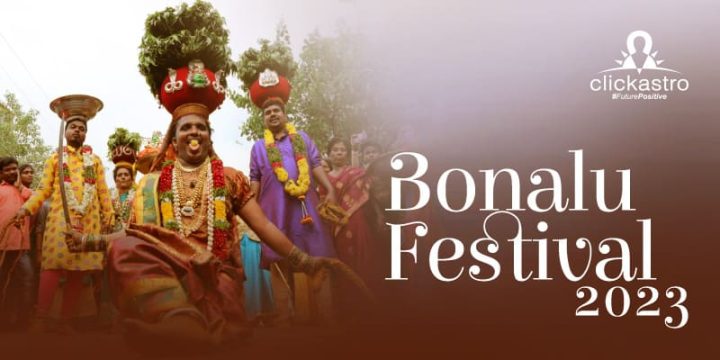Contents[hide]
- Golconda Bonalu: June 22
- Secunderabad Bonalu: July 9
- Hyderabad Bonalu: July 16
- Bonalu in other parts of Telangana: Every Sunday during the Ashada month
The Sacred Rituals of the Bonalu Festival
The enchanting tapestry of rituals, from the colorful attire of women to the rhythmic beats of drums, carries deep significance and reflects the reverence towards Goddess Mahakali. It makes the Bonalu festival a truly captivating celebrationThe Graceful Attire
As Bonalu commences, women adorn themselves in elegant saris, while teenage girls dress in half sarees or Lehenga cholis, bedecked with intricate ornaments. This attire symbolizes grace and adds to the festive ambiance, creating a visual spectacle of tradition and beauty.Trance Dance
In homage to the local goddess, tranced women perform a mesmerizing dance, balancing pots on their heads to the resounding beats of drums. Their rhythmic movements and entranced state exemplify the deep connection with the divine and serve as a captivating spectacle for the devotees.Symbolic Sacrifice
While in the past, male buffaloes were sacrificed in front of the temple, this practice has now been replaced with the offering of roosters. The sacrifice is believed to ward off evil spirits and protect the community from harm. It is a symbolic gesture of devotion and a way to seek the blessings of the goddess.Bonalu Trance
Women who carry the Bonam pot on their heads are believed to embody the spirit of the mother goddess. As they make their way toward the temple, people pour water on their feet to calm the spirit within them. This act symbolizes reverence and respect for the divine presence carried by these women.Thottela
As a mark of respect to the deity, devotees create colorful paper structures supported by bamboo sticks. These structures, known as Thottela, are an integral part of the ritual offerings. They add a vibrant and artistic touch to the festivities and showcase the devotion and creativity of the devotees.Pothuraju
According to mythology, Pothuraju is the brother of Goddess Mahakali and plays a significant role in the festival. A well-built man dressed in a red dhoti adorns his body with turmeric and applies kumkum on his forehead. Known as Pothuraju, he dances in front of the Palaharam Bandi (Yatra) and acts as the initiator of the festivities and protector of the community. With lashing whips and neem leaves tied around their waists, he leads the ladies under the spell of the goddess to the temple.The Feast
Following the first yatra (procession), the Bali or sacrifice ritual takes place. A rooster or goat is sacrificed, and a grand feast is prepared using the meat. The feast becomes a joyful occasion for families and relatives to come together and partake in the blessings and abundance bestowed by the goddess. Along with meat, alcohol, and palm tree wine, the feast symbolizes gratitude and communal harmony.Rangam and Ghatam Ceremonies
The fourth Sunday marks the concluding ceremonies of Bonalu. The Rangam ceremony involves a woman standing atop an earthen pot, invoking spiritual power, and offering the art of foretelling the future to devotees. This captivating ceremony allows devotees to seek insights into their lives and receive guidance. Finally, the Ghatam ceremony takes place, where a pot decorated like a goddess, known as Ghatam, is carried by a priest dressed in traditional attire. The priest’s body is adorned with turmeric, signifying purity and sanctity. Get Your Free Horoscope PredictionsThe History of the Bonalu Festival
The Origin of Bonalu
The origins of Bonalu can be traced back to the belief that Goddess Mahakali visits her maternal home during the Ashada month. Just as a daughter is warmly welcomed into her family’s abode, devotees express their love, respect, and devotion through dance, offering pots of food, bangles, and sarees to the Goddess. The festival symbolizes the joyous reunion between the Goddess and her people, with special meals prepared to delight and appease her.The Deity: Goddess Mahakali
Goddess Mahakali is a fierce Hindu deity associated with calamity and dread. Depicted in ancient Hindu scriptures, she represents the primordial energy of the cosmos. In artwork, she is often portrayed with a blue-black complexion, four arms holding weapons, a demon head and skull cup, fangs, disheveled hair, fierce eyes, and a protruding tongue. She adorns a skirt made of demon arms and a necklace crafted from 108 demon hands. Some depictions depict her with ten heads, emphasizing her formidable nature.The Significance of Bonalu in Telangana’s History
In 1813, a devastating plague swept through the cities of Hyderabad and Secunderabad. During this challenging time, the military stationed in Hyderabad prayed fervently to Goddess Maha kali, seeking an end to the epidemic. They made a solemn promise that if their prayers were answered, they would erect an idol of the Goddess in the cities. Miraculously, the plague subsided, and true to their word, the military constructed the idol and commenced the tradition of offering Bonalu. Since then, the people of Telangana have faithfully observed this ceremony, expressing their gratitude and devotion to the Goddess who protected them during their time of need.Bonalu festival significance
Bonalu transcends religious boundaries and unites people from various communities, fostering a sense of togetherness and harmony. The festival showcases the rich cultural heritage of Telangana and the opportunity to relish the mouthwatering Telangana cuisine, with a myriad of flavors and aromatic dishes like pulihora (tamarind rice), vada, garelu (lentil fritters), and authentic sweets that tantalize the taste buds and bring joy to the festivities.Community Unity and Bonding
Bonalu brings people from different communities together, fostering a sense of unity and camaraderie. Regardless of caste, creed, or social status, devotees join in the festivities, participate in processions, and offer their devotion to the goddess. The festival strengthens social bonds, promotes harmony, and reinforces the spirit of communal harmony.Spiritual and Emotional Upliftment
 Bonalu is a time for spiritual introspection and personal growth. Devotees immerse themselves in the rituals, devotional songs, and prayers, which provide solace, inspiration, and a sense of connection with the divine. The festival evokes deep emotions of devotion, gratitude, and surrender, creating a sacred atmosphere that uplifts the spirit and rejuvenates the soul.
Bonalu is a time for spiritual introspection and personal growth. Devotees immerse themselves in the rituals, devotional songs, and prayers, which provide solace, inspiration, and a sense of connection with the divine. The festival evokes deep emotions of devotion, gratitude, and surrender, creating a sacred atmosphere that uplifts the spirit and rejuvenates the soul.







